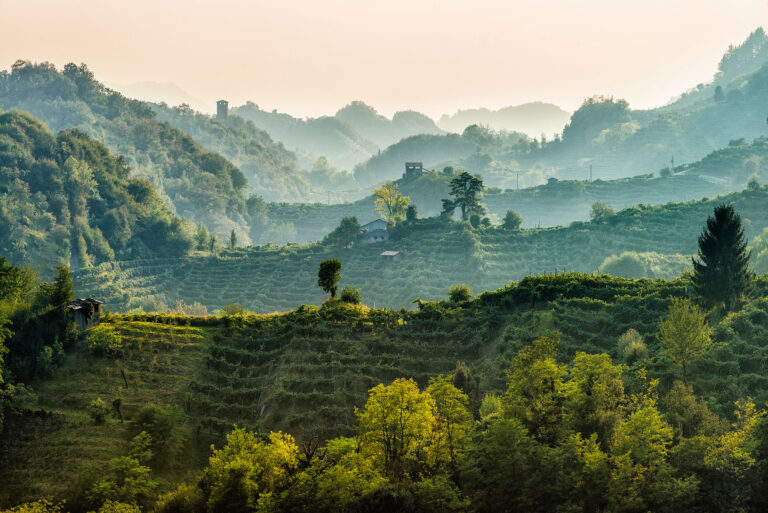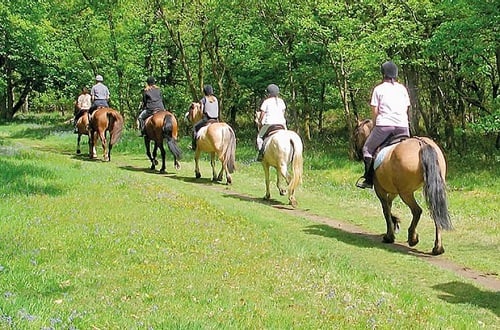The kingdom of Prosecco DOCG extends over a wide strip of hills crossed by the Piave river.
The itinerary is divided into two possible routes that develop on both sides of the river:
– the first explores the “Strada del Prosecco and Wines of the Conegliano Valdobbiadene Hills”, starting from Conegliano and arriving in Vittorio Veneto;
– the second instead starts from Valdobbiadene and, after crossing the Piave, enters the hills of Montello, a renowned wine area of Asolo Prosecco DOCG and a land full of splendid villas.
Let’s find out together!
____________
First itinerary
Conegliano
The first route starts from Conegliano, which since 1877 has been the seat of the Agricultural Technical Institute, specializing in viticulture and enology techniques.
For a visit to the historic center you can start from via XX Settembre, overlooked by some frescoed houses and the portico of the Scuola dei Battuti, which forms the facade of the cathedral. The interior of the cathedral, from the fourteenth century, houses numerous works of art, including some paintings by Palma il Giovane and Cima da Conegliano. Adjacent to the cathedral is the School of the Confraternity of Santa Maria dei Battuti, a 16th century frescoed building.
In Conegliano it is also possible to visit the old castle, an ancient fortress of the tenth century of which only the severed tower and the bell tower remain, which houses the Civic Museum consisting of an archaeological section and a picture gallery, where paintings by the most famous Venetian masters are exhibited . A few steps from the castle is Villa Gera, from the 19th century, one of the masterpieces of Giuseppe Japelli, a Venetian architect who loves the neoclassical style.
The parish church of San Pietro di Feletto
From Conegliano go up to San Pietro di Feletto, which in addition to being one of the main production centers of Prosecco docg, offers a splendid panoramic view and is a very characteristic locality. In San Pietro you can visit the ancient parish church, dating back to the period between the twelfth and thirteenth centuries.
Valdobbiadene: the Cartizze palace
From San Pietro di Feletto continue east and reach Valdobbiadene, known throughout the world for the production of both excellent quality Prosecco and the rarer Cartizze.
The town is very old and numerous findings testify to the presence of man since the Bronze Age. In the historic center, the parish church is worth a visit. Inside there are many works of art and especially paintings signed by masters such as Palma the Younger and Paris Bordon. In the rectory there is a portrait of Blessed Barbarigo painted by Rosalba Carriera, a famous Venetian painter.
The village of Follina
From Valdobbiadene you go up towards the north-east in the direction of Vittorio Veneto.
The road that connects Valdobbiadene to Vittorio Veneto is the most spectacular in the Prosecco DOCG area. In fact, in the first part it follows the succession of hills with wide curves and offers suggestive views over all the great vineyards and the numerous producing companies, often located in ancient patrician residences.
About halfway you can visit Follina, where the characteristic medieval village remains. Inside the village there is an ancient Cistercian abbey dating back to the fourteenth century.
Vittorio Veneto
After the stop in Follina, continue slightly downhill passing by the two small lakes of Revine and finally reach the bottom of the valley where Vittorio Veneto is located, the last stage of the first route.
The city was born in 1866, after the unification of Italy, from the merger of two ancient towns, Ceneda and Serravalle. In the village of Serravalle, the duomo, or cathedral of Santa Maria Nova, is worth a visit, which preserves a famous altarpiece painted in 1547 by Titian on the main altar. The central square is very interesting, surrounded by Venetian-style buildings with the town hall tower adorned with two clocks. The lower one, dated 1487, with twenty-four hour numbering in Gothic characters and Arabic numerals, is an extraordinary rarity.
A very steep road leads to the castle of San Martino, now a bishopric, perhaps built in the Lombard period but remodeled in the 15th century. Two towers and part of the central core of the building remain of the ancient complex.
Second itinerary
War memories in Nervesa della Battaglia
The second route crosses the hilly area of Montello, south of the Piave, and starts again from Valdobbiadene.
After crossing the Piave across the Priula bridge, you enter the territory of Montello, which owes its fame to the fine wines produced here and to the fact that some episodes of the First World War took place there.
The first stop on this route is Nervesa della Battaglia. The town is dominated by the ossuary monument, where the remains of soldiers who died in the battles of the First World War are collected. In Nervesa there are also the ruins of the Abbey of Sant’Eustachio, built in the early 11th century and entrusted to the Benedictine monks.Maser and Palladio’s masterpiece
Following the course of the Piave, proceed towards Crocetta del Montello, turn left and after a few minutes, having crossed the town of Cornuda, you will arrive at Maser.
A small town full of important wineries, Maser owes its fame above all to villa Barbaro. Built at the behest of the Barbaro brothers, the villa is considered the masterpiece of the architect Andrea di Pietro della Gondola, known as “Il Palladio”. It can be reached from the road that runs at the foot of the hill, where the famous Tempietto stands, also by Palladio. The interior preserves valuable stuccos and sculptures, alongside the frescoes by the painter Paolo Caliari, known as “il Veronese”. At the top of the hill on which the villa lies, in a well-restored rustic house, the Museum of carriages is set up.
Asolo
From Maser you quickly reach Asolo, a town located on the hills and characterized by ancient villas surrounded by immense gardens.
Asolo is also the most important wine center of Montello and is full of cellars where the fine wines of the area are produced, from Prosecco to Merlot.
A staircase leads to the cathedral, built on the remains of Roman baths. Inside, with three naves, a precious baptismal font and numerous paintings by Venetian masters are preserved.
Then there is the Queen’s castle, of which only the tower with the clock and parts of the walls and the Council hall remain today.
Also worth a visit is the Antica Tessoria Asolana, which produces silks colored with the colors present in the frescoes of the Venetian villas.
Walking along a staircase of over 100 steps that starts from Piazza Brugnoli, you can reach the fortress, a polygonal building probably from the pre-Roman era.
The villas of Montebelluna
From Asolo, the itinerary returns to the Piave, touching the most famous places in Montello as regards the production of wines. The first town you meet is Montebelluna.
The ancient history of the town is documented by the presence of finds from the ancient Venetians and Roman necropolises and archaeological material found in Montello and now preserved in the Villa Biagi Civic Museum.
In Montebelluna you can visit the old cathedral, or church of Santa Maria in Colle, built in the seventeenth century and subsequently remodeled. Moving away from the center you can visit the splendid villas that surround the city. Among these, Villa Biagi, from the 18th century, seat of the Civic Museum as mentioned, and Villa Binetti-Zuccareda. Inside the latter there is the Shoe Museum, which exhibits all the prototypes of sports shoes on which Montebelluna bases its thriving economy.
Volpago del Montello
On the return journey to the Priula bridge, it is worth making a last stop in Volpago del Montello. The most representative building of Volpago is Villa Spineda Loredan, built in the mid-eighteenth century on a project by the architect Francesco Maria Preti; but the parish church is also worth a visit, which preserves an altarpiece by P. Damini (1592-1631) on the main altar.
In the kingdom of Prosecco, itinerary freely taken from www.discoveritalia.it
Ulteriori informazioni su questo testo di originePer avere ulteriori informazioni sulla traduzione è necessario il testo di origine
Invia commenti
Riquadri laterali
Maser and Palladio’s masterpiece
Following the course of the Piave




